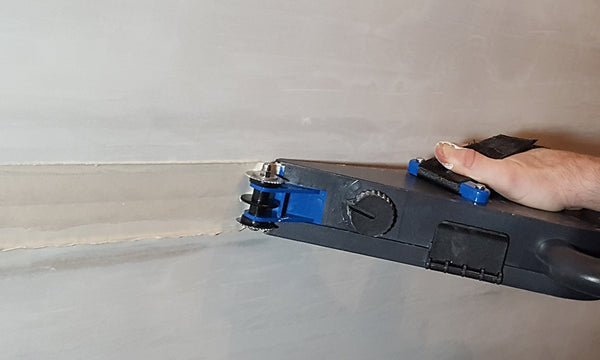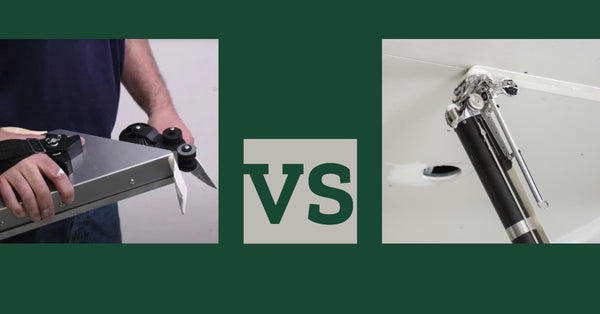Award Winning Service
Award Winning Service


A Drywall Taping Banjo is a specialized tool used by construction and home improvement professionals to streamline the process of applying joint tape and mud during drywall installation. This tool significantly expedites the taping phase of drywall finishing, enhancing productivity and efficiency.
The mechanism of a drywall taping banjo is fairly straightforward. The tool holds a roll of tape which is fed through a mud-filled compartment. As you pull the tape through the banjo, it becomes evenly coated with drywall mud on one side. The freshly mudded tape can then be applied directly to the joints between drywall sheets, saving the step of manually mudding the tape.
Using a drywall taping banjo is simple once you get the hang of it. Fill the mud compartment with an appropriate amount of joint compound, ensuring it has the right consistency. Once the mud and tape are loaded, you can begin applying the tape along the seams of the drywall. Hold the banjo at an angle against the wall, allowing the tape to come out flat and smooth.
While applying the tape, ensure that you maintain even pressure to allow for a consistent layer of mud on the tape. Also, use a drywall knife to press and smooth the tape against the wall, removing any excess mud and air bubbles in the process.
One of the great features of a drywall taping banjo is its adaptability. Most models come with adjustable mud flow settings, allowing you to control the amount of mud applied to the tape based on the specific requirements of your project.
For corners and other tricky areas, some drywall taping banjos come with a corner attachment. This tool allows you to tape and mud both sides of an interior corner in one step, making it a valuable time-saver.
Using a drywall taping banjo can significantly speed up the taping process, especially for larger jobs. However, it requires some practice to perfect the technique. If you're new to using this tool, it might be worthwhile to practice on some scrap drywall before tackling a major project.
The use of a drywall taping banjo brings a host of benefits, especially when compared to traditional hand taping methods. For one, it drastically increases efficiency. When manually applying joint compound and tape, the process can be time-consuming and meticulous. In contrast, a drywall taping banjo combines these two steps, applying an even layer of mud directly onto the tape as it's dispensed, thus speeding up the process.
Another advantage lies in consistency. A well-adjusted drywall taping banjo provides a uniform layer of mud onto the tape, eliminating guesswork and reducing the potential for error. This uniformity helps to ensure a smooth, flat finish on the drywall seams, which contributes to a professional end result. The consistency offered by a taping banjo can be particularly beneficial for less experienced users or DIY enthusiasts who may struggle with achieving the correct mud thickness using traditional methods.
The drywall taping banjo also has its perks when it comes to handling corners and challenging areas. Some models come with an attached corner applicator, allowing for simultaneous taping and mudding of both sides of an inside corner. This feature can be a major timesaver, especially in rooms with a large number of corners. It also removes the challenge of manually applying tape and mud to corners, which can be a tricky skill to master.
When working on large-scale projects, the drywall taping banjo can be a game-changer. Hand taping can become physically demanding over time, with the repeated need to load up a taping knife with mud and apply tape. By combining these steps, a banjo reduces fatigue, allowing for more prolonged work periods, which can be critical on larger jobs or in professional settings where time is money.
Lastly, a drywall taping banjo encourages cleanliness. With traditional taping, there's a greater risk of dropping or splattering joint compound, which can be hard to clean up, especially when dried. Since a banjo contains the mud within a compartment, it reduces the potential for mess, leading to easier cleanup and less waste.
Proper adjustment of your drywall taping banjo is crucial for achieving the best results. First, you'll want to focus on the mud consistency. The joint compound should be mixed to a creamy consistency, similar to that of thick paint. This allows it to flow smoothly onto the tape.
The next adjustment is the mud flow. Most drywall taping banjos have a control mechanism that allows you to adjust the thickness of the mud being applied to the tape. This can typically be adjusted by a dial or knob on the tool. The ideal setting will depend on your project and the type of tape you're using, but generally, a thin, consistent layer of mud is what you're aiming for.
Thirdly, consider the tape tension. The tape should be tight enough that it doesn't sag, but not so tight that it's difficult to pull out of the banjo. The tension is typically controlled by a brake or tension screw on the tool. You'll want to adjust this so that the tape comes out easily when you pull, but not so loose that it unrolls freely.
Lastly, some models of drywall taping banjos come with a corner adapter like the Delko Zunder Taping Banjo and the Advanced Even Flow Taping Banjo. This adapter allows you to tape and mud inside corners in one step. If your banjo has this feature, ensure it's properly attached and adjusted to apply a consistent layer of mud to both sides of the corner.
By correctly adjusting your drywall taping banjo, you'll optimize its performance, reduce wastage of materials, and ensure a higher quality finish. It's also worth noting that the optimal adjustments may vary depending on the specific model of the banjo, the nature of the work, and the type of tape used. Always refer to the manufacturer's instructions for specific guidance.

Comparing a drywall taping banjo to an automatic taping tool like an Automatic Taper, reveals similarities and differences based on functionality, ease of use, cost, and project size suitability.
In terms of functionality, both tools aim to streamline and simplify the process of taping and mudding drywall. They both dispense pre-mudded tape, which can be directly applied to drywall seams. However, automatic tapers often have a more complex design and can perform additional functions like creasing tape for corner applications and cutting tape with a simple trigger mechanism.
Ease of use is another aspect to consider. A drywall taping banjo is generally simpler and more straightforward to use, making it suitable for beginners or smaller projects. However, it does require a certain amount of manual control to maintain a consistent layer of mud on the tape and to cut the tape at the right spot. On the other hand, an automatic taper, once mastered, can make the job even easier and faster, as it automates more functions, but it might have a steeper learning curve.
From a cost perspective, drywall taping banjos tend to be more affordable than automatic tapers. Banjos are simpler in design, and their manufacturing cost is lower, which reflects in their retail price. Automatic tapers, with their more complex mechanisms and additional functions, are usually more expensive. This cost can be justified for professionals who regularly work on large drywall projects, but might not be cost-effective for occasional users or small-scale DIY projects.
At Timothy's Toolbox, we understand the importance of using the right tools for your drywall finishing and taping needs. We offer a wide range of quality tools, from banjos to automatic tapers, each designed to streamline your work, reduce fatigue, and achieve a professional finish.
{"one"=>"Select 2 or 3 items to compare", "other"=>"{{ count }} of 3 items selected"}
Leave a comment